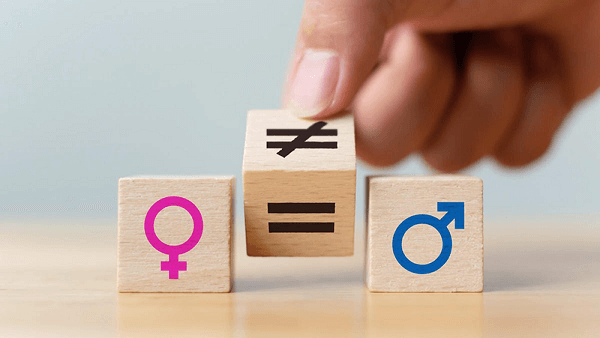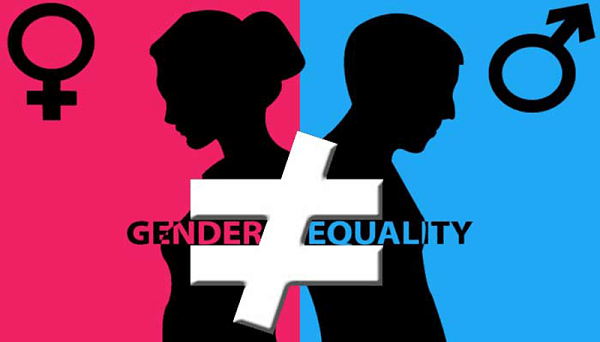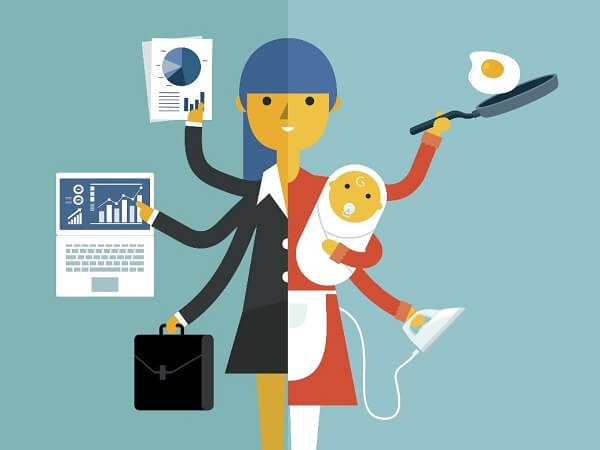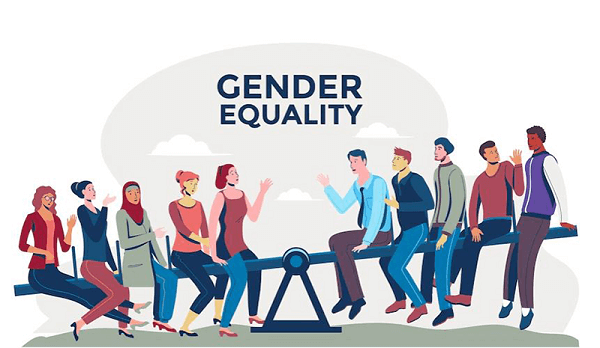Gender Discrimination EssayThe difference in treatment of people based on their sex that places them at a disadvantage or prevents them from availing of opportunities that are open to other members of society is known as gender discrimination. Most countries practise gender discrimination, with males typically holding higher positions in social, economic, and political hierarchies. Their gender roles produce differences, which usually culminates in unfair treatment throughout life. There has been discrimination against women for many generations, and it still persists in advanced societies. But as society progresses, it's time to abandon such ideas of gender roles. 
Examples of Gender DiscriminationIn addition to institutional and state-level settings, person-to-person interactions can also involve gender discrimination. It might happen:
It's crucial to realise that discrimination against people based on their gender can also include people based on their ethnicity, class, disability, or sexual orientation. 
Causes of Gender DiscriminationThe globe has made progress toward achieving gender equality over time. In many parts of the world, there are greater economic opportunities, better healthcare options, and higher representation of women in politics. But according to the World Economic Forum, it will be another century before complete gender equality is achieved. Ten reasons for gender inequality are listed below: 1. Unequal Access to EducationThe globe has made progress toward achieving gender equality over time. Women continue to have less access to educational opportunities than males do globally. One-fourth of young women ages 15 to 24 will drop out of elementary school. This category accounts for 58% of those who do not finish that basic education. Two-thirds of the world's illiterate people are women. Girls' futures and the options they will have are greatly impacted when they are not educated to the same level as boys. 2. Employment DiscriminationOnly six nations in the world grant women the same legal rights to employment as do males. In fact, women in most economies only have 3/4 of the rights that men enjoy. According to studies, creating a more level playing field in the workplace would have a good snowball impact on other sectors that are prone to gender disparity. 3. Job SegregationThe division of labour is one factor in gender disparity in the workplace. There is an ingrained notion in most countries that men are just more capable of doing particular tasks. Those are typically the jobs with the highest salaries. Because of this inequality, women earn less money. Women are also primarily responsible for performing unpaid work, and therefore even if women work in paid employment, they perform extra tasks that are never paid for. 4. Dearth of Legal SafeguardsOver a billion women lack legal protection from domestic economic or sexual violence, according to research from the World Bank. Both have a profound effect on women's capacity to flourish and enjoy freedom. Additionally, there are frequently no legal safeguards against harassment at work, in school, or in public. Without protection, women frequently have to make choices that undermine and restrict their ambitions in these risky environments. 5. Lack of Corporeal AutonomyMost women around the world lack control over their own bodies and having children. Birth contraception is usually very difficult to obtain. Over 200 million women who don't want to become pregnant are not taking contraception, according to the World Health Organization. This is due to a number of factors, including a lack of options, restricted access, and cultural and religious hostility. Around 40% of pregnancies worldwide are unplanned, and while 50% of them eventually terminate in abortion, 38% of them give birth. 6. Inadequate Health CareMost women around the world lack control over their own bodies and having children. In addition to having less access to contraception than men, women generally receive poorer healthcare services. This is related to other factors that contribute to gender inequality, such as the fact that more women experience poverty due to a lack of employment and educational options. They have a lower chance of being able to afford quality medical treatment. Additionally, fewer studies have been done on diseases, including autoimmune disorders and chronic pain syndromes, that are more prevalent in women than men. The discrimination and dismissal widen the gender disparity in healthcare quality that many women encounter from their doctors. 7. Inadequate Religious FreedomWomen are most negatively impacted when religious freedom is violated. The World Economic Forum asserts that gender disparity increases when extreme ideologies (like ISIS) enter a community and impose restrictions on religious freedom. Researchers from Georgetown University and Brigham Young University were able to link religious intolerance and women's capacity to engage in the economy in their study. Kudos to women's engagement; economies become more stable when there is greater religious freedom. 8. Political UnderrepresentationWomen occupied only 24.3% of seats in national parliaments at the beginning of 2019. There were 11 female heads of state as of June 2019. Women are still glaringly underrepresented in politics and governance, despite years of improvement in this area. As a result, problems like maternity leave and childcare, pensions, legislation enforcing gender equality, and gender-based violence that female politicians frequently bring up are frequently disregarded. 9. RacismWithout addressing racism, a discussion of gender inequality would be unthinkable. It has an impact on the types of occupations that women of colour can obtain, the pay they receive, how the legal and healthcare systems see them, and more. Racism and gender inequality have long had a tight relationship. Professor and author Sally Kitch claimed that European colonists in Virginia chose which labour may be taxed based on the race of the woman doing the work. Employment done by African women was considered "labour," making it taxable, whereas English women's work was considered "domestic," making it non-taxable. Pay disparities between white women and women of colour carry on this history of prejudice and exacerbate gender inequality. 10. Societal AttitudesAlthough it may not be as obvious as some of the other factors on this list, a society's general mentality has a big effect on gender inequality. Whether it's employment, the legal system, or healthcare, how society views men and women differently and how much they are worth is prominent in all of these areas. Although progress can be made through laws and institutional changes, there is frequently opposition after periods of significant change because gender beliefs run deep. Men and women alike frequently fail to recognise other forms of gender inequity when they occur, such as when women are more evenly represented in leadership positions. These conceptions support gender inequity and stall meaningful change. 
Impact of Gender Discrimination on Mental HealthGender discrimination is a stressor, and like all stressors, it can have a negative impact on mental health. According to research by 2020, women who said they had experienced gender discrimination in the previous 12 months performed better on a depression screening instrument than other women. Being the target of prejudice can cause anxiety and psychological trauma, depending on the circumstances. According to the research paper's authors, prejudice significantly contributes to the "gender gap" in mental disease rates. Most mental health issues are more prevalent in women, including:
Biological reasons could contribute to these discrepancies in people who were born with the gender ascribed to them. Studies have discovered less gender disparity in the prevalence of mental illness in countries where men and women are treated equally. This shows that injustice and discrimination have a significant impact on these inequalities. Gender discrimination, according to the World Health Organization (WHO), increases the likelihood of gender-based violence. Worldwide, 30% of women have been victim of physical or sexual abuse at some point in their life. The rate is greater (47%), and it is considerably higher for trans individuals of colour, those who have engaged in sex work, those who have gone through homelessness, and those who currently or in the past had a handicap. A mental health disorder can develop as a result of any kind of abuse or assault, as well as additional problems that are stressful in and of themselves. For instance, a survivor of a sexual assault may become pregnant, catch a sexually transmitted disease, or lose their place in society. Impact of Gender Discrimination on Physical HealthPhysical health is impacted both directly and indirectly by gender discrimination. These consist of: IllnessAccording to several studies, being the target of prejudice is associated with poorer physical health. For instance, a 2018 study discovered that women who suffer sexual harassment at work, in particular, are much more likely to report being in poor physical health. Numerous chronic diseases, such as diabetes, high blood pressure, and chronic pain, can also be exacerbated by stress, which can come from any source. Less Favorable Living ConditionsA person may experience harsher living standards and less access to the resources they require to survive and prosper as a result of gender discrimination. For instance, the gender pay disparity in the United States results in women generally earning less than males, even while doing the same jobs. For women of colour, the pay difference is greater. As compared to men, women also experience higher rates of poverty, greater levels of student debt, and poorer retirement savings. This not only increases stress but also makes it more difficult for someone to afford healthy food, a secure place to live, and health insurance. As a result, there are unnecessary and unfair inequalities between the health of disadvantaged groups and that of privileged ones, leading to health disparity. Injury and DemiseViolence resulting from discrimination has a direct influence on health as well. Another illustration of this is female genital mutilation (FGM). FGM, which primarily affects young females under the age of 15, involves needless surgical procedures to remove all or part of the genitalia. FGM may be practised because communities think it will improve girls' purity, make them more suitable for marriage, and reduce their likelihood of engaging in extramarital sex. Those who make it through the treatment may have excruciating agony, bleeding, infections, and lasting issues with their sexual health. Health complications cause some people to pass away. Broader Impact of Gender DiscriminationThe health and happiness of individuals are negatively impacted by sexism. Discrimination can have a negative impact on a person's health, which can then affect their family, friends, and the larger social group. According to a 2017 study, gender discrimination has a negative impact on children's health and development as well as on women's employment and poverty rates. Indirectly, sexism hurts men as well. Men who feel pressured to conform to male norms may avoid obtaining medical attention when necessary, act in ways that are harmful to their health, or engage in violent behaviour. This carries a significant financial burden. The global economy suffers a $12 trillion, or 16%, loss due to institutionalised gender discrimination, according to a 2016 study. Status of Gender Discrimination Around The WorldHalf of the world's population is made up of women and girls, who also holds half of the world's potential. In addition to being a fundamental human right, gender equality is crucial for the creation of peaceful societies, the realisation of all human potential, and sustainable development. Furthermore, it has been demonstrated that empowering women boosts economic growth and productivity. Every day, boys and girls witness gender discrimination in their families, neighbourhoods, textbooks, the media, and even among the adults who are responsible for raising them. The burden of caring and domestic duties may fall disproportionately on moms when parents share household responsibilities. Additionally, many girls in schools receive less encouragement than boys to pursue their academic interests. There are many reasons why this occurs, including the possibility that girls' concerns for safety, hygiene, and sanitation are disregarded, preventing them from routinely attending class. Gender differences in learning and skill development are also a result of discriminatory teaching methods and educational resources. As a result, as opposed to 1 in 10 boys, roughly 1 in 4 girls between the ages of 15 and 19 are neither employed nor enrolled in an educational programme. Furthermore, gender discrepancies in early childhood start out mild. In addition to having better survival rates at birth, girls are also more likely to be developing normally and attend preschool. In every nation where data are available, girls typically surpass boys in reading among those who complete secondary school. But as adolescence approaches, considerable obstacles to females' well-being may arise. Gender stereotypes and discrimination increase their risk of unintended pregnancy, HIV and AIDS, and malnutrition. Girls are shut off from the information and resources they need to stay healthy and safe, particularly in emergency situations and locations where menstruation is still considered taboo. Gender inequality can take violent forms, which are the most pernicious. 13 million females between the ages of 15 and 19-or about 1 in 20-have engaged in forced sex. Adolescent girls are most at risk of experiencing gender-based violence during both peaceful and violent times. Even though both female genital mutilation and child marriage have been recognised globally as human rights breaches, hundreds of millions of girls worldwide continue to be exposed to these practices. Violence can also occur during childbirth, for example, in areas where female infanticide is known to be a problem. Gender norms that are detrimental are reinforced at all levels. They become ingrained in laws and practises that fail to maintain - or even undermine - the rights of girls in some nations, such as those that prevent women from inheriting property. Gender norms harm boys as well because they can encourage child labour, gang violence, dropout rates from school, and recruitment into armed organisations. Importance of Gender EqualityGender equality is the idea that girls, boys, and women all have the same opportunities, rights, and responsibilities. Equality does not imply that men and women will become equal, but rather that each gender's rights, obligations, and opportunities will be independent of the gender they were given at birth. Gender equality emphasises that both men's and women's interests, needs, and priorities are taken into account, respecting the diversity of various groupings of men and women. In addition to being a human rights problem, equality between men and women is also considered a requirement for and a sign of sustainable people-centred development. The achievement of all people's rights to equal treatment under the law depends on gender equality. The ultimate goal of gender equality is to create a society where men and women have the same opportunities, rights, and responsibilities in every aspect of life. Men and women are equal when they can equally participate in the allocation of power and influence, have equal opportunities to achieve financial freedom through employment or business ownership, have equal access to education and the chance to pursue personal goals, interests, and talents, share parental responsibilities and are totally free from coercion, harassment, and gender-based violent behaviour both at work and at home. Gender equality is important in the context of population and development programmes because it will empower both men and women to make choices that will have a beneficial influence on their own sexual and reproductive health as well as the well-being of their partners and families. The attainment of gender equality stands to enhance decision-making with regard to matters like age at marriage, the timing of births, usage of contraception and resorting to harmful practices (such as female genital mutilation). But it's crucial to recognise that, in cases of gender inequality, women are typically left out or treated unfairly when it comes to making decisions and having access to financial and social resources. The empowerment of women, with an emphasis on recognising and remedying power disparities and allowing women more agency to govern their own lives, is thus a crucial component of advancing gender equality. They would then be allowed to decide what to do and how to do it to attain and preserve their own sexual and reproductive well-being. Men and women do not become equal as a result of gender equality or women's empowerment; rather, access to resources and lifestyle changes are not contingent on or limited by a person's sex. 
The attainment of gender equality necessitates transformations for both men and women. A redefining of women's and men's rights and obligations in the household, the workplace, and society as a whole is necessary in order to create more egalitarian relationships. Hence, it's imperative to acknowledge gender as a component of men's personal identity. Since the tendency is to view male characteristics and traits as the norm and those of women as variations of the norm, this reality is frequently neglected. However, gender has just as much of an impact on men's lives as it does on women's. Men are put under pressure and have their behaviour shaped by societal standards, ideas about what it means to be a man, and the responsibilities of men as fathers, husbands, and sons. Young males are encouraged to take risks as a result of socialisation in the home and later in school, which is frequently reinforced by peer pressure and media portrayals. Men are, therefore, frequently more exposed to higher risks of illness and mortality than women due to the lifestyles that their professions call for. These dangers include those related to mishaps, aggression, and drinking. 
Men should be given a chance to play a more caregiving role because they have the same rights as women. However, males also have obligations when it comes to the sexual and reproductive health of themselves, their partners, and their children. Acknowledging men's unique health issues, as well as their demands and the environments that develop them, is necessary to fulfil these rights and obligations. Adopting a gender perspective is a crucial first step since it shows that trends of gender disparity result in costs and downsides for males. Additionally, it emphasises how important it is to consider how the roles, duties, and demands of men and women interact with one another in order to achieve gender equality. Progress Made Towards Gender Equality So FarGirls and young women continue to bear the added responsibility of being both young and feminine in many parts of the world. They frequently deal with gender-biased social and political systems, negative cultural attitudes and practises, and opportunities that are restricted and their self-worth diminished. Girls refuse to set limits on their aspirations in the face of significant obstacles that continue to deny them equal rights. The world has seen inconsistent progress since the Beijing Declaration and Platform for Action, the most inclusive political platform for gender equality, was signed in 1995. In order to minimise gender discrimination and put boys, girls, women, and men on equal ground, the World Programme of Action for Youth (WPAY) recognises this dilemma and recommends that a gender-sensitive approach be taken in the planning and implementation of social and economic programmes and policies. 
More and more females are enrolling in and completing their education, and fewer of them are getting married or having children while still being children. But prejudice and restrictive stereotypes are still widespread. Women face new obstacles as a result of technological advancement and humanitarian crises while enduring older ones like violence, institutionalised bigotry, and limited educational and employment prospects. Girls from various backgrounds are bravely speaking out against inequity because of this. In order to demonstrate their ability to affect change on a global scale, girl-led initiatives are putting an end to child marriage and female genital mutilation, calling for action on climate change, and breaking new ground in the disciplines of science, technology, engineering, and math (STEM). The needs and aspirations of girls and young women are being met, and advancement has been made in this area. Education for girls has improved. The number of girls out of school decreased from 65 million in 1995 to 32 million in 2020, in lower secondary, from 52 million to 30 million, in upper secondary, from 91 million to 67 million, while the literacy rate for young women of girls aged 15-24 grew from 80% in 1995 to 90% in 2020. Conclusion and Way ForwardThe unfair mistreatment of people on the basis of their gender is known as gender discrimination. This involves marginalising someone due to their gender identity or giving favours to a particular gender. Gender discrimination takes many different forms, including unequal pay, sexual misconduct, and lowered or denied access to rights like healthcare and education. This prejudice has a negative impact on both mental and physical health, contributes to poverty, establishes and maintains cycles of abuse and violence, and limits access to medical care. Addressing gender discrimination at the individual level necessitates introspection and a readiness to adapt. Furthermore, gender discrimination is a systemic problem, as the facts demonstrate. According to the World Economic Forum, achieving gender equality will cost 135.6 years. Women in the world only have 68% of the rights, opportunities, and access to resources that males do, based on 2017 World Economic Forum (WEF) research. These discrepancies, as well as the rate at which they are being reduced, vary from nation to nation. It's overwhelming, but the best part is that there is a growing global awareness of the need to combat gender inequality, which is frequently linked to other forms of discrimination, including racism, xenophobia, and homophobia. Equal rights are proving to be advantageous. According to Research by the International Labour Organization, a reduction in the global gender wage gap of 25% by 2025 would result in a rise in the workforce of 204 million people and a US$5.8 trillion gain in global GDP. The global economy might gain from closing the pay gap in a variety of other ways as well. According to a 2017 analysis by the Institute for Women's Policy Research, raising the wages of all U.S. women workers to parity with those of males in comparable occupations would increase the GDP of that nation by 2.8 per cent. Learning about the causes, signs, and impacts of gender discrimination will help us take action to stop it. Sharing household duties at home and advocating for equal pay for similar occupations can both be helpful. Learning about the causes, signs, and impacts of gender discrimination will help us take action to stop it. However, it's not just up to us to make the world better. Each of us is a part of the same wave. Gender disparity cannot be eradicated by just altering how we interact with others and insisting that others do the same. Only until the institutions that have an impact on our lives alter will there be meaningful change. These significant challenges shouldn't generate discouragement because every modest victory represents a step closer to the overall objective. Ensuring one is always managing their personal welfare since taking care of oneself allows us to continue to promote gender equality.
Next TopicEssay on Picnic
|
 For Videos Join Our Youtube Channel: Join Now
For Videos Join Our Youtube Channel: Join Now
Feedback
- Send your Feedback to [email protected]
Help Others, Please Share










